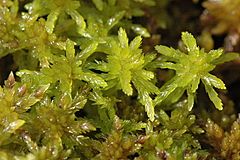Sphagnum facts for kids
Quick facts for kids Sphagnum |
|
|---|---|
 |
|
| Sphagnum flexuosum | |
| Scientific classification | |
| Kingdom: | |
| Phylum: | |
| Class: |
Sphagnopsida
|
| Order: |
Sphagnales
|
| Family: |
Sphagnaceae
|
| Genus: |
Sphagnum
|
Sphagnum is a special type of moss that can hold a lot of water. It's often called peat moss. There are about 120 different kinds, or species, of Sphagnum moss. Both living and dead Sphagnum plants are amazing at soaking up water. They can hold up to 20 times their dry weight in water, and some can even hold up to 1 billion times! This makes them very important for their environment.
Contents
What is Sphagnum Moss?
Sphagnum moss is a small, green plant that grows in wet places. Unlike many other plants, it doesn't have true roots. Instead, it absorbs water and nutrients directly through its leaves and stems.
How Sphagnum Stores Water
Sphagnum moss has special cells that are like tiny sponges. These cells are empty when dry, but they can quickly fill with water. This ability to hold so much water helps the moss survive in places where water levels change. It also helps other plants that grow nearby.
Where Does Sphagnum Grow?
Sphagnum moss loves wet, cool places. It grows in wetlands, especially in areas called peat bogs. These bogs are found in temperate parts of the world, which have mild climates.
Creating Peat Bogs
Sphagnum moss is a key part of how peat bogs are formed. When the moss dies, it doesn't fully rot away because the water in bogs is often very acidic and low in oxygen. Over thousands of years, layers of dead Sphagnum moss build up to form peat. Peat is a dark, spongy material that can be used as fuel or in gardening.
Why is Sphagnum Important?
Sphagnum moss and the peat bogs it creates are very important for our planet.
Home for Wildlife
Peat bogs are unique habitats for many plants and animals. Some rare and special plants, like carnivorous plants, can only grow in these bogs. Many birds, insects, and other creatures also depend on bogs for their homes and food.
Storing Carbon
Peat bogs are like giant carbon storage units. They hold a huge amount of carbon dioxide, a gas that contributes to climate change. When peat bogs are healthy, they help keep this carbon out of the atmosphere. This makes them important in the fight against global warming.
Uses of Sphagnum Moss
Humans have found many uses for Sphagnum moss and peat over the years.
Gardening and Agriculture
Peat moss is often added to garden soil. It helps the soil hold water and air, which is good for plants. It's also used to grow plants in pots, especially those that like acidic conditions, like blueberries and rhododendrons.
Historical Uses
In the past, Sphagnum moss was used for many things. Because it's so good at soaking up liquids and has some natural antiseptic properties, it was used as wound dressings during wars, especially in World War I. It was also used as a natural diaper material and for insulation in homes.
Images for kids
-
Sphagnum with northern pitcher plants (Sarracenia purpurea) at Brown's Lake Bog, Ohio
-
Sphagnum moss wound dressings being made at the University of Toronto c. 1914
-
Mer Bleue Conservation Area, a large, protected Sphagnum bog near Ottawa, Ontario, Canada
See also
 In Spanish: Musgo de turbera para niños
In Spanish: Musgo de turbera para niños








